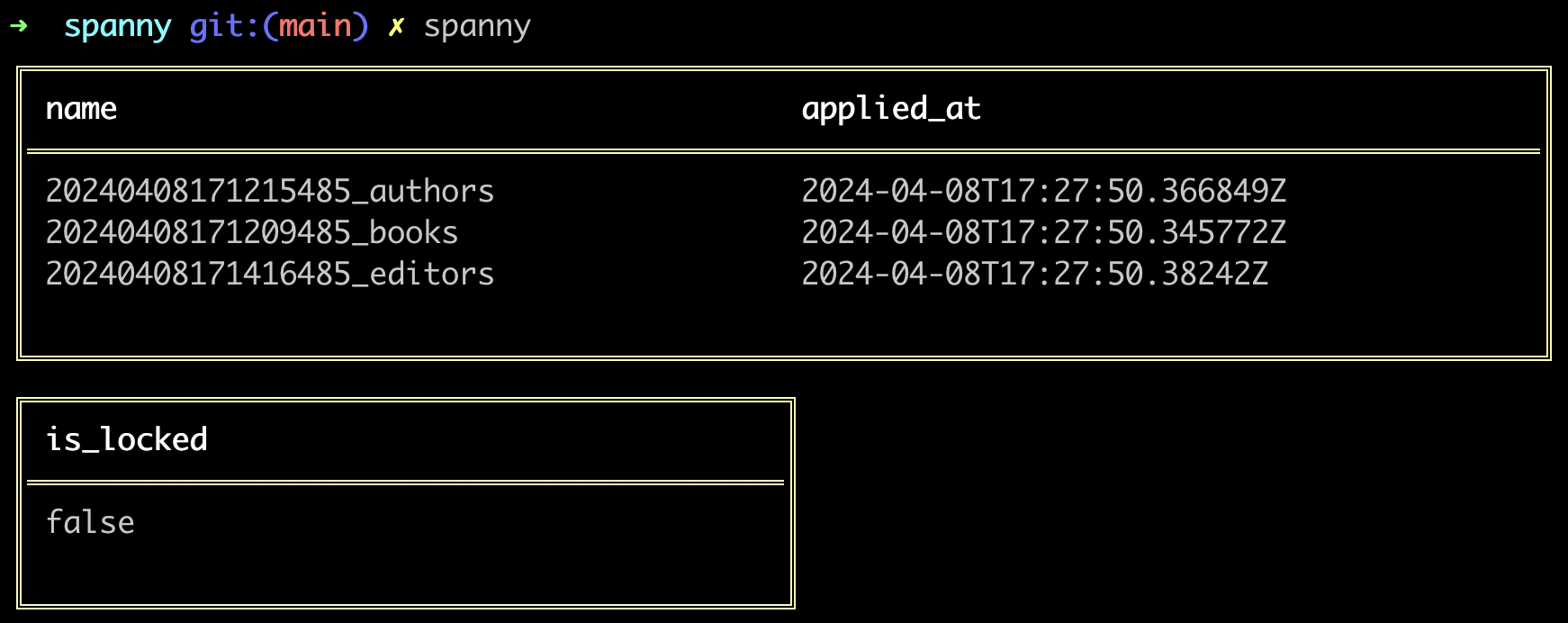Spanny is a CLI that helps you manage schema migrations with a Spanner Database. It was created to help working locally with the Google Spanner Emulator.
Disclaimer: It's my first project in golang
For now there is no tooling for installing Spanny as it is just something for my personal usage. If you want to use it too you must have golang installed on you computer. Then you can:
- Clone this repo
- Run :
$ go build .at the root of the repository It will create thespannyexecutable that you can use on your machine as you like.
By default $ spanny will display the current migration status. It shows the migration currently applied and if the migration table is locked or not.
To create a new migration file just type $ spanny create-ddl my_migration. This will generate a folder (20240408171209485_DML_my_migration) in the path you've declared in the .spannyrc file (migrationFilesPath). This folder will contain a up.sql and a down.sql file to respectively implement your up and down DDL queries. You'll need to separate each request with a ;.
It's the same principle as to create a DDL migration. Just type: $ spanny create-dml my_migration.
You can see examples in the migrations folder of this repository.
To display the help just type $ spanny -h
Here is an overview of the current help display. Prefer using the $ spanny -h command as it will be up to date.
Usage:
spanny [flags]
spanny [command]
Available Commands:
all Apply all available migrations
apply Apply the next migration
completion Generate the autocompletion script for the specified shell
config Print Spanny current configuration
create-db Create a Spanner database with the given name or default to the config file value
create-ddl Create migration files for DDL modification
create-dml Create migration files for DML modification
create-instance Create a Spanner instance with the given name or default to the config file value
help Help about any command
init Will create the instance, database and utility migration tables
init-migration Will create the migration utility table in the database
list List migration files
list-db List databases
list-tables List tables files
query Run a read only query against the database
reset Rollback all migrations
rollback Rollback last migration
state Displays the current state of migrations
update Run insert or update against the database
version Print Spanny version number
Flags:
-c, --config string Indicate the configuration path (default "./")
-e, --env string Specify spanner environment (default "default")
-h, --help help for spanny
-v, --verbose Makes spanny more verbose
Use "spanny [command] --help" for more information about a command.
Spanny will by default search for a .spannyrc.json file in the current directory. You can specify a path to your config file with the flag --config or -c.
$ spanny -c "./path/to/my/config"
Configuration Example:
{
"migrationFilesPath": "./migrations",
"servicePath": "localhost",
"port": 9010,
"envs": {
"staging": {
"project": "staging-platform",
"instance": "staging-instance",
"database": "staging-database"
},
"production": {
"project": "production-platform",
"instance": "production-instance",
"database": "production-database"
},
"default": {
"project": "local-platform",
"instance": "local-instance",
"database": "local-database",
"use-emulator": true
},
"test": {
"project": "test-platform",
"instance": "test-instance",
"database": "test-database",
"use-emulator": true
}
}
}You can follow this google guide to run the Spanner emulator locally.
Remember to also export this environment variable: export SPANNER_EMULATOR_HOST=localhost:9010
Here are some command to start the container with podman:
-
Run the container:
podman run --name spanner-emul -d -e SPANNER_EMULATOR_HOST=localhost:9010 -p 9010:9010 -p 9020:9020 gcr.io/cloud-spanner-emulator/emulator -
Stop the emulator:
podman stop spanner-emul -
Restart the emulator:
podman start spanner-emul
- Check migrations tables exist in default command.
- Support also inserts and updates in migrations (use
ddlanddmlsufffix to separate them). - Implement lock migration table during migrations.
